Kwanggyoon Seo
Neural Face Skinning for Mesh-agnostic Facial Expression Cloning
May 28, 2025
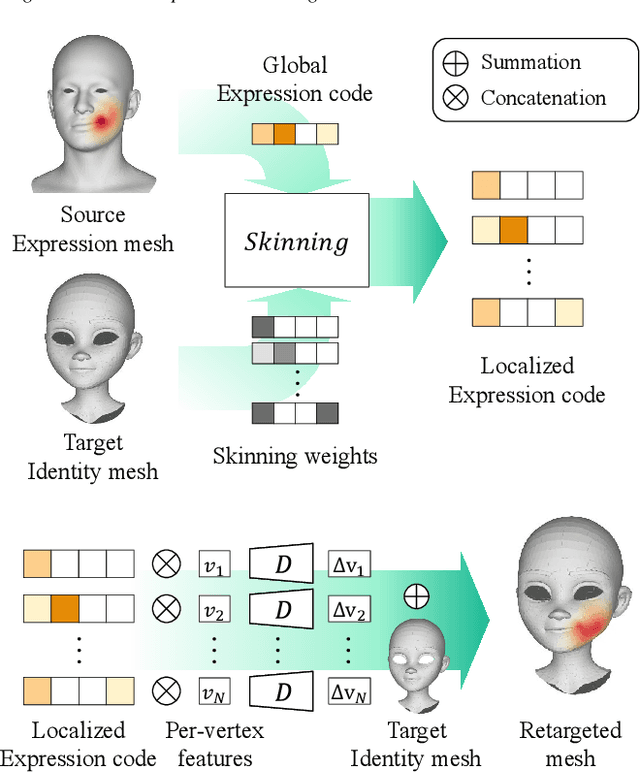
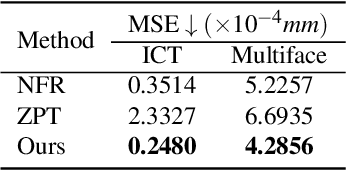
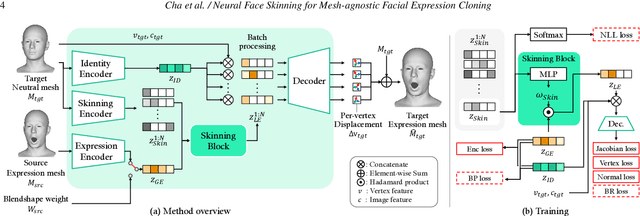
Abstract:Accurately retargeting facial expressions to a face mesh while enabling manipulation is a key challenge in facial animation retargeting. Recent deep-learning methods address this by encoding facial expressions into a global latent code, but they often fail to capture fine-grained details in local regions. While some methods improve local accuracy by transferring deformations locally, this often complicates overall control of the facial expression. To address this, we propose a method that combines the strengths of both global and local deformation models. Our approach enables intuitive control and detailed expression cloning across diverse face meshes, regardless of their underlying structures. The core idea is to localize the influence of the global latent code on the target mesh. Our model learns to predict skinning weights for each vertex of the target face mesh through indirect supervision from predefined segmentation labels. These predicted weights localize the global latent code, enabling precise and region-specific deformations even for meshes with unseen shapes. We supervise the latent code using Facial Action Coding System (FACS)-based blendshapes to ensure interpretability and allow straightforward editing of the generated animation. Through extensive experiments, we demonstrate improved performance over state-of-the-art methods in terms of expression fidelity, deformation transfer accuracy, and adaptability across diverse mesh structures.
NeRFFaceSpeech: One-shot Audio-driven 3D Talking Head Synthesis via Generative Prior
May 10, 2024
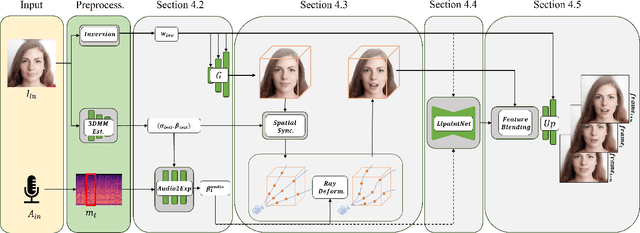
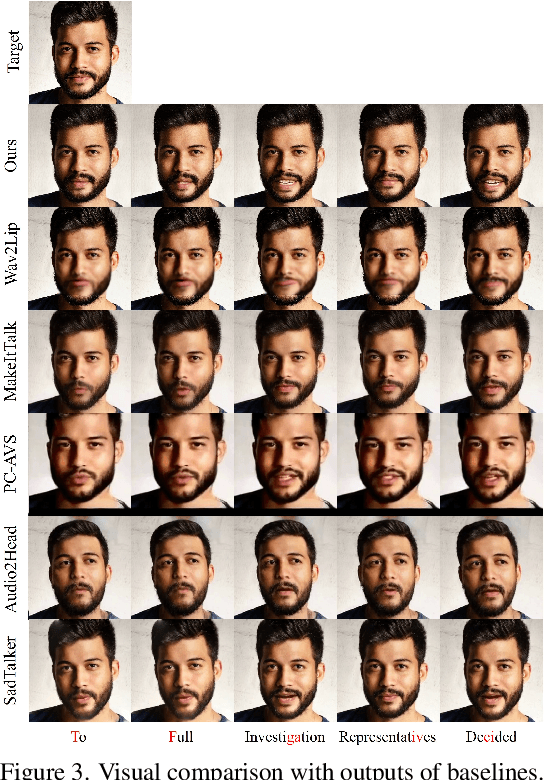
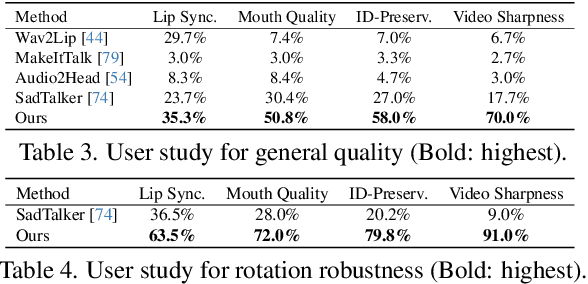
Abstract:Audio-driven talking head generation is advancing from 2D to 3D content. Notably, Neural Radiance Field (NeRF) is in the spotlight as a means to synthesize high-quality 3D talking head outputs. Unfortunately, this NeRF-based approach typically requires a large number of paired audio-visual data for each identity, thereby limiting the scalability of the method. Although there have been attempts to generate audio-driven 3D talking head animations with a single image, the results are often unsatisfactory due to insufficient information on obscured regions in the image. In this paper, we mainly focus on addressing the overlooked aspect of 3D consistency in the one-shot, audio-driven domain, where facial animations are synthesized primarily in front-facing perspectives. We propose a novel method, NeRFFaceSpeech, which enables to produce high-quality 3D-aware talking head. Using prior knowledge of generative models combined with NeRF, our method can craft a 3D-consistent facial feature space corresponding to a single image. Our spatial synchronization method employs audio-correlated vertex dynamics of a parametric face model to transform static image features into dynamic visuals through ray deformation, ensuring realistic 3D facial motion. Moreover, we introduce LipaintNet that can replenish the lacking information in the inner-mouth area, which can not be obtained from a given single image. The network is trained in a self-supervised manner by utilizing the generative capabilities without additional data. The comprehensive experiments demonstrate the superiority of our method in generating audio-driven talking heads from a single image with enhanced 3D consistency compared to previous approaches. In addition, we introduce a quantitative way of measuring the robustness of a model against pose changes for the first time, which has been possible only qualitatively.
LeGO: Leveraging a Surface Deformation Network for Animatable Stylized Face Generation with One Example
Mar 22, 2024Abstract:Recent advances in 3D face stylization have made significant strides in few to zero-shot settings. However, the degree of stylization achieved by existing methods is often not sufficient for practical applications because they are mostly based on statistical 3D Morphable Models (3DMM) with limited variations. To this end, we propose a method that can produce a highly stylized 3D face model with desired topology. Our methods train a surface deformation network with 3DMM and translate its domain to the target style using a paired exemplar. The network achieves stylization of the 3D face mesh by mimicking the style of the target using a differentiable renderer and directional CLIP losses. Additionally, during the inference process, we utilize a Mesh Agnostic Encoder (MAGE) that takes deformation target, a mesh of diverse topologies as input to the stylization process and encodes its shape into our latent space. The resulting stylized face model can be animated by commonly used 3DMM blend shapes. A set of quantitative and qualitative evaluations demonstrate that our method can produce highly stylized face meshes according to a given style and output them in a desired topology. We also demonstrate example applications of our method including image-based stylized avatar generation, linear interpolation of geometric styles, and facial animation of stylized avatars.
StyleCineGAN: Landscape Cinemagraph Generation using a Pre-trained StyleGAN
Mar 21, 2024
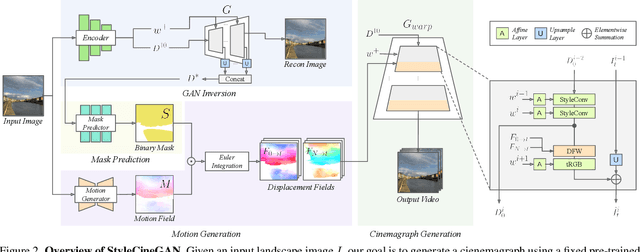
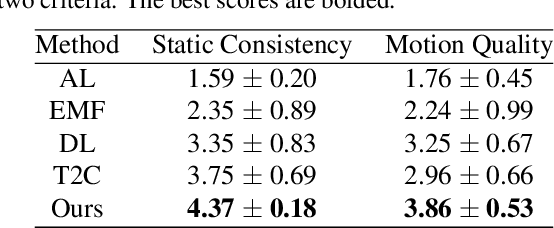

Abstract:We propose a method that can generate cinemagraphs automatically from a still landscape image using a pre-trained StyleGAN. Inspired by the success of recent unconditional video generation, we leverage a powerful pre-trained image generator to synthesize high-quality cinemagraphs. Unlike previous approaches that mainly utilize the latent space of a pre-trained StyleGAN, our approach utilizes its deep feature space for both GAN inversion and cinemagraph generation. Specifically, we propose multi-scale deep feature warping (MSDFW), which warps the intermediate features of a pre-trained StyleGAN at different resolutions. By using MSDFW, the generated cinemagraphs are of high resolution and exhibit plausible looping animation. We demonstrate the superiority of our method through user studies and quantitative comparisons with state-of-the-art cinemagraph generation methods and a video generation method that uses a pre-trained StyleGAN.
Stylized Face Sketch Extraction via Generative Prior with Limited Data
Mar 17, 2024Abstract:Facial sketches are both a concise way of showing the identity of a person and a means to express artistic intention. While a few techniques have recently emerged that allow sketches to be extracted in different styles, they typically rely on a large amount of data that is difficult to obtain. Here, we propose StyleSketch, a method for extracting high-resolution stylized sketches from a face image. Using the rich semantics of the deep features from a pretrained StyleGAN, we are able to train a sketch generator with 16 pairs of face and the corresponding sketch images. The sketch generator utilizes part-based losses with two-stage learning for fast convergence during training for high-quality sketch extraction. Through a set of comparisons, we show that StyleSketch outperforms existing state-of-the-art sketch extraction methods and few-shot image adaptation methods for the task of extracting high-resolution abstract face sketches. We further demonstrate the versatility of StyleSketch by extending its use to other domains and explore the possibility of semantic editing. The project page can be found in https://kwanyun.github.io/stylesketch_project.
Representative Feature Extraction During Diffusion Process for Sketch Extraction with One Example
Jan 09, 2024Abstract:We introduce DiffSketch, a method for generating a variety of stylized sketches from images. Our approach focuses on selecting representative features from the rich semantics of deep features within a pretrained diffusion model. This novel sketch generation method can be trained with one manual drawing. Furthermore, efficient sketch extraction is ensured by distilling a trained generator into a streamlined extractor. We select denoising diffusion features through analysis and integrate these selected features with VAE features to produce sketches. Additionally, we propose a sampling scheme for training models using a conditional generative approach. Through a series of comparisons, we verify that distilled DiffSketch not only outperforms existing state-of-the-art sketch extraction methods but also surpasses diffusion-based stylization methods in the task of extracting sketches.
Generating Texture for 3D Human Avatar from a Single Image using Sampling and Refinement Networks
May 01, 2023Abstract:There has been significant progress in generating an animatable 3D human avatar from a single image. However, recovering texture for the 3D human avatar from a single image has been relatively less addressed. Because the generated 3D human avatar reveals the occluded texture of the given image as it moves, it is critical to synthesize the occluded texture pattern that is unseen from the source image. To generate a plausible texture map for 3D human avatars, the occluded texture pattern needs to be synthesized with respect to the visible texture from the given image. Moreover, the generated texture should align with the surface of the target 3D mesh. In this paper, we propose a texture synthesis method for a 3D human avatar that incorporates geometry information. The proposed method consists of two convolutional networks for the sampling and refining process. The sampler network fills in the occluded regions of the source image and aligns the texture with the surface of the target 3D mesh using the geometry information. The sampled texture is further refined and adjusted by the refiner network. To maintain the clear details in the given image, both sampled and refined texture is blended to produce the final texture map. To effectively guide the sampler network to achieve its goal, we designed a curriculum learning scheme that starts from a simple sampling task and gradually progresses to the task where the alignment needs to be considered. We conducted experiments to show that our method outperforms previous methods qualitatively and quantitatively.
Fast and Accurate Single-Image Depth Estimation on Mobile Devices, Mobile AI 2021 Challenge: Report
May 17, 2021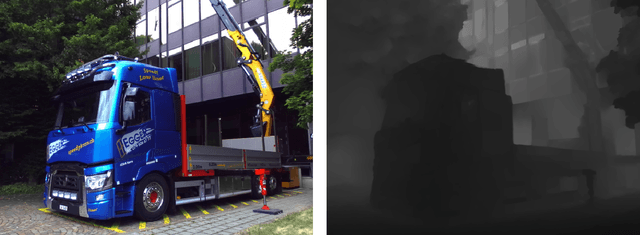

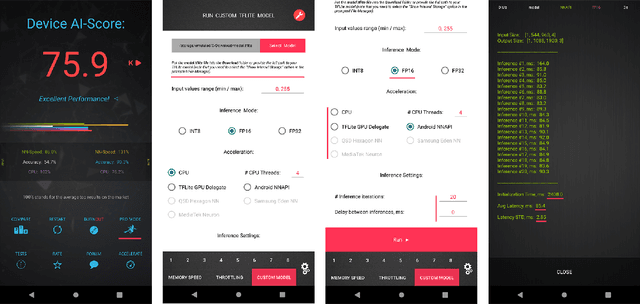

Abstract:Depth estimation is an important computer vision problem with many practical applications to mobile devices. While many solutions have been proposed for this task, they are usually very computationally expensive and thus are not applicable for on-device inference. To address this problem, we introduce the first Mobile AI challenge, where the target is to develop an end-to-end deep learning-based depth estimation solutions that can demonstrate a nearly real-time performance on smartphones and IoT platforms. For this, the participants were provided with a new large-scale dataset containing RGB-depth image pairs obtained with a dedicated stereo ZED camera producing high-resolution depth maps for objects located at up to 50 meters. The runtime of all models was evaluated on the popular Raspberry Pi 4 platform with a mobile ARM-based Broadcom chipset. The proposed solutions can generate VGA resolution depth maps at up to 10 FPS on the Raspberry Pi 4 while achieving high fidelity results, and are compatible with any Android or Linux-based mobile devices. A detailed description of all models developed in the challenge is provided in this paper.
Neural Crossbreed: Neural Based Image Metamorphosis
Sep 02, 2020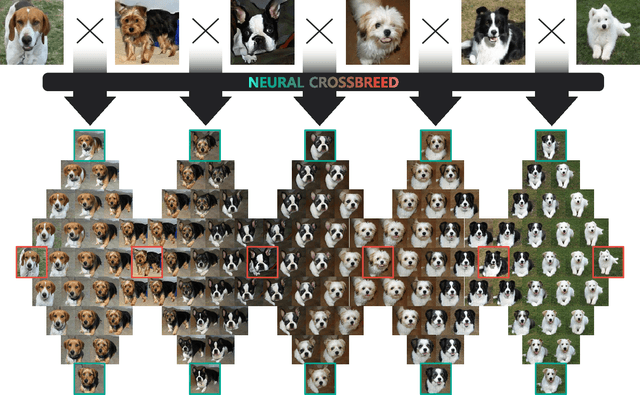
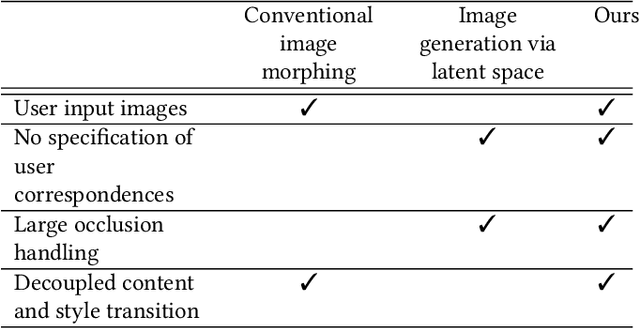

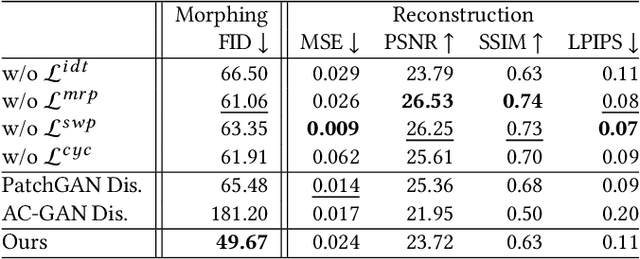
Abstract:We propose Neural Crossbreed, a feed-forward neural network that can learn a semantic change of input images in a latent space to create the morphing effect. Because the network learns a semantic change, a sequence of meaningful intermediate images can be generated without requiring the user to specify explicit correspondences. In addition, the semantic change learning makes it possible to perform the morphing between the images that contain objects with significantly different poses or camera views. Furthermore, just as in conventional morphing techniques, our morphing network can handle shape and appearance transitions separately by disentangling the content and the style transfer for rich usability. We prepare a training dataset for morphing using a pre-trained BigGAN, which generates an intermediate image by interpolating two latent vectors at an intended morphing value. This is the first attempt to address image morphing using a pre-trained generative model in order to learn semantic transformation. The experiments show that Neural Crossbreed produces high quality morphed images, overcoming various limitations associated with conventional approaches. In addition, Neural Crossbreed can be further extended for diverse applications such as multi-image morphing, appearance transfer, and video frame interpolation.
 Add to Chrome
Add to Chrome Add to Firefox
Add to Firefox Add to Edge
Add to Edge